
This quarter, I want to highlight several important updates and reminders to help keep everyone informed and prepared for radiological and nuclear incidents and the ones that happen more frequently.
With summer storms approaching, it is crucial to have an emergency plan in place. Ensure you have an emergency kit, including essentials like water, non-perishable food, medications, pet supplies and a first aid kit. Familiarize yourself with community resources and have a communication plan with your family. As we enjoy the summer weather, remember to stay hydrated and protect yourself from the sun with sunscreen and appropriate weather clothing. Be mindful of heat-related illnesses and take regular breaks if you engage in strenuous outdoor activities. You can find more information about how to get prepared for emergencies at https://www.in.gov/dhs/get-prepared/
With the increasing focus on sustainable energy sources, it is important to understand the safety measures for nuclear energy. Nuclear facilities are designed with multiple safety systems and are monitored continuously to prevent accidents. In the unlikely event of a nuclear incident, it is vital to promptly follow local, state and federal official instructions. Stay informed about the latest safety protocols and ensure you know the location of nearby emergency shelters and nuclear facilities.
IDHS is here to support you. If you have any questions, concerns or suggestions, please do not hesitate to reach out. Your safety and well-being are our top priorities, and we are committed to providing you with the information and support you need.
Stay safe and vigilant,
|
Indiana REP Coordinator.
Leksi King
Nuclear Emergency Preparedness: Quick Guide
 In the event of a nuclear emergency, preparation is crucial to ensure the safety of you and your loved ones. Here are some essential steps and guidelines to follow:
1. Understanding Nuclear Emergencies:
- Types of emergencies: Know the difference between nuclear power plant accidents, radiological dispersion devices ("dirty bombs") and nuclear explosions. Each scenario requires a different response.
- Immediate actions: Quickly determine whether to evacuate or shelter-in-place based on official guidance.
2. Preparation Before an Emergency:
- Emergency kit: Assemble a kit that includes water, non-perishable food, a battery-powered radio, extra batteries, flashlights, first aid supplies, medications and important documents.
- Family plan: Develop a communication and evacuation plan with your family. Ensure everyone knows where to go and how to get there safely.
- Know your zone: Familiarize yourself with the emergency zones around nuclear facilities and understand the evacuation routes and shelter locations.
3. During a Nuclear Emergency:
- Shelter-in-place: Stay where you are if advised to stay indoors and go to a basement or the center of a building. Close windows and doors, and turn off ventilation systems to prevent radioactive material from entering.
- Evacuation: Follow evacuation orders promptly. Keep your emergency kit and a battery-powered radio with you to stay informed about the situation.
4. Staying Informed:
- Emergency alerts: Sign up for local emergency alerts and notifications. Listen to official announcements via radio, television or trusted online sources.
- Radiation levels: Be aware of the recommended safety levels for radiation exposure and follow decontamination procedures if necessary.
5. After the Emergency:
- Return home safely: Only return home when authorities declare it safe. Follow instructions for decontaminating yourself and your belongings.
- Health monitoring: Pay attention to your health and seek medical attention if you experience symptoms of radiation sickness.
Being prepared for a nuclear emergency can significantly reduce the risks to your health and safety. Stay informed, have a plan and ensure your emergency supplies are ready. By taking these steps, you can protect yourself and your family in the event of a nuclear incident.
First Radioactive Rhino Horns to Curb Poaching in South Africa
 The Rhisotope project, launched by South African scientists, holds significant promise not only for wildlife conservation but also for advancing radiation technology and safety measures in the US, Indiana and the broader radiation community. By injecting radioactive material into rhino horns to deter poaching, this initiative demonstrates a novel application of radiation that could inspire similar protective measures for other endangered species and valuable resources. For the US and Indiana, adopting such innovative methods can enhance efforts in wildlife conservation, bolster anti-poaching strategies and provide a new frontier for applying radiation in practical, life-saving ways.
Furthermore, the radiation community can benefit from the research and development insights gained through this project, potentially leading to new protocols and technologies that enhance the detection and management of radioactive materials. The Rhisotope project exemplifies how creative scientific approaches can address global challenges, offering valuable lessons and opportunities for collaboration and advancement in radiation science. |